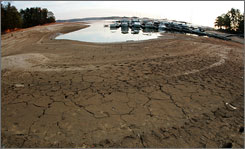ATLANTA – Georgians will be able to water their azaleas and swim in their pools this spring after the state eased a ban on outdoor watering.Barely 400 miles away, residents of Raleigh, N.C., should be so lucky. Their city council just enacted the toughest water restrictions available, essentially banning all outdoor watering in Raleigh and six surrounding towns.

As the historic drought gripping much of the Southeast stretches into a second year, Atlanta and Raleigh find themselves in similar drought conditions but are adopting contrasting strategies.
Both depend on a U.S. Army Corps of Engineers lake for drinking water – Atlanta on Lake Lanier, Raleigh on Falls Lake. Both have experienced explosive growth that is straining water supplies. Both are still among the hardest-hit places in the region as the drought shows the first signs of abating.
North Carolina environmentalists say Raleigh shouldn’t aspire to be like Atlanta in water management. “Up here, we constantly point to Atlanta as the failed example of what happens when you don’t plan,” says Dean Naujoks of the Neuse River Foundation. “I’m hopeful we don’t make the same mistakes Atlanta has made.”
Others say it’s unfair to single out Atlanta because the entire Southeast has taken water for granted for centuries. In recent decades, the region has been a Sun Belt growth engine, adding people and impervious surfaces such as concrete and rooftops with little regard to whether there would be enough water.
“I would not just point the finger at Atlanta,” says Graeme Lockaby, director of the Auburn University Water Resources Center in Alabama. “All of us in the Southeast are probably guilty of that. Until the last 10, 15, 20 years, we always had plenty of water. Then we had this acceleration of people and development.”
He says this drought has made people realize that water is a finite resource. That reality is sharpening tensions as state and local officials across the region fight the drought and begin planning for the next one:
•Georgia Gov. Sonny Perdue last week relaxed the watering ban one day after a federal appeals court said Georgia needs congressional approval to increase the amount of water it takes out of Lake Lanier, metro Atlanta’s main water source. Lanier also supplies users in Alabama and Florida.
The ruling was a victory for the two neighboring states in their 18-year water war with Georgia. Alabama Gov. Bob Riley said the ruling blocked Georgia’s “massive water grab.”
•Two Georgia legislators last week introduced legislation that would effectively move the state’s northern border to include part of the Tennessee River, a move they say would correct an 1818 surveyor’s error.
“The boundary between Georgia and Tennessee is the 35th parallel,” state Sen. David Shafer says. “The 1818 survey party erroneously marked the 35th parallel about 1 mile south of its actual location. It’s not a matter of changing the border, but … accurately surveying the border.”
The bills, which enjoy near-unanimous support in both chambers, could ignite a bitter water war with Tennessee. Gov. Phil Bredesen says he’ll fight any Georgia attempt to siphon water from Tennessee.
•A South Carolina state senator is pushing a bill that would allow the state to control withdrawals of more than 3 million gallons a day from the state’s rivers and lakes. Last year, South Carolina sued North Carolina over a plan by the North Carolina cities of Concord and Kannapolis to withdraw 10 million gallons a day from the Catawba River. The suit is pending in the U.S. Supreme Court.
As the Southeast keeps growing, such fights are likely to intensify and multiply, says William Ferris, associate director of the Center for the Study of the American South at the University of North Carolina at Chapel Hill. “You’re absolutely going to see more of this kind of tension,” he says. “We can see it out West in places like California and Arizona over the water in the Colorado River. We’ll see that here.”
There were some glimmers of hope last week from the U.S. Drought Monitor, which tracks conditions nationwide. Recent rainfall is expected to bring improvement in Virginia, southeastern Kentucky, eastern Tennessee and the western Carolinas. Drought conditions are likely to persist in central Alabama, central Georgia, the eastern Carolinas and southwest Florida, according to the monitor’s 90-day outlook.
“There has been some easing of conditions in the Southeast,” says climatologist Mark Svoboda of the National Drought Mitigation Center. “But are they totally out of the woods yet? Not by any means.”
Perdue nonetheless announced that residents of 61 north Georgia counties, banned from watering outdoors since September, will be allowed to do so during certain hours three days a week, but without sprinklers. They’ll have to use a garden hose with a spray nozzle that shuts off when it’s released. Residents also will be allowed to fill outdoor swimming pools this spring and summer.
The restrictions were relaxed to ease the crunch on the state’s $8.12 billion landscape industry, says Marshall Guest, a Perdue spokesman.
Sally Bethea, executive director of the environmental group Upper Chattahoochee Riverkeeper, says easing the restrictions while the drought continues “really sends a mixed message. Unfortunately, many of us, if given an inch, will take a mile. We should be tightening our belts further.”
Source: USA TODAY
Commentary from the Infinite Unknown:
Water will become the new oil….with all the consequences (war, etc.)